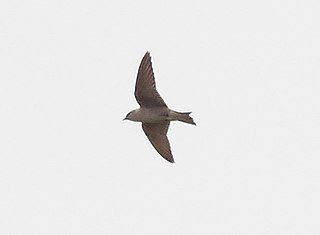The greater hamster-rat, greater long-tailed pouched rat, or long-tailed pouched rat is a species of rodent in the family Nesomyidae. It is found in Malawi, Tanzania, and Zambia. Its natural habitats are subtropical or tropical moist lowland forest and subtropical or tropical moist montane forest. It is threatened by habitat loss.
Mikaniopsis vitalba is a species of flowering plant in the family Asteraceae. It is found in Angola, Cameroon, Democratic Republic of the Congo, Gabon, and Uganda. Its natural habitats are subtropical or tropical moist lowland forests, subtropical or tropical swamps, subtropical or tropical moist montane forests, and moist savanna. It is threatened by habitat loss.
Aplastodiscus albofrenatus is a species of frog in the family Hylidae, endemic to Brazil. Its natural habitats are subtropical or tropical moist lowland forests, rivers, plantations, rural gardens, and heavily degraded former forests. It is threatened by habitat loss.

Aplastodiscus albosignatus, also known as the Bocaina treefrog, is a species of frog in the family Hylidae. It is endemic to Brazil. Its natural habitats are subtropical or tropical moist lowland forests, subtropical or tropical moist montane forests, and rivers. It is threatened by habitat loss.

Aplastodiscus arildae is a species of frog in the family Hylidae. It is endemic to Brazil. Its natural habitats are subtropical or tropical moist lowland forests and rivers.

Aplastodiscus cavicola is a species of frog in the family Hylidae. It is endemic to Brazil. Its natural habitats are subtropical or tropical moist lowland forests and rivers. It is threatened by habitat loss.

Aplastodiscus ehrhardti is a species of frog in the family Hylidae. It is endemic to Brazil. Its natural habitats are subtropical or tropical moist lowland forests and intermittent freshwater marshes. It is threatened by habitat loss; however, despite this, it remains in the "Least Concern" category "in view of its relatively wide distribution, presumed large population, and because it is unlikely to be declining fast enough to qualify for listing in a more threatened category".
Aplastodiscus flumineus is a species of frog in the family Hylidae. It is endemic to Brazil. Its natural habitats are subtropical or tropical moist montane forests and rivers. It is threatened by habitat loss.

Aplastodiscus leucopygius is a species of frog in the family Hylidae, endemic to Brazil. Its natural habitats are subtropical or tropical moist lowland forests, rivers, intermittent freshwater marshes, plantations, rural gardens, heavily degraded former forests, and irrigated land.
Aplastodiscus musicus is a species of frog in the family Hylidae. It is endemic to Brazil. Its natural habitats are subtropical or tropical moist montane forests and rivers. It is threatened by habitat loss.

Aplastodiscus perviridis is a species of frog in the family Hylidae. It is found in Argentina, Brazil, and possibly Paraguay. Its natural habitats are subtropical or tropical moist lowland forests, subtropical or tropical moist montane forests, subtropical or tropical moist shrublands, subtropical or tropical dry lowland grasslands, rivers, and freshwater marshes.

Craugastor stejnegerianus is a species of frog in the family Craugastoridae. It is found in Costa Rica and Panama. Its natural habitats are subtropical or tropical dry forests, subtropical or tropical moist lowland forests, subtropical or tropical moist montane forests, pastureland, plantations, and heavily degraded former forest. It is threatened by habitat loss.

Leptodactylus fuscus is a species of frog in the family Leptodactylidae. Its local names are rã-assobiadora.

The robust frog is a species of frog in the family Microhylidae. It is endemic to Australia. Its natural habitats are subtropical or tropical moist lowland forests and subtropical or tropical moist montane forests. It is threatened by habitat loss.

The long-snout torrent frog is a species of frogs in the family Ranidae.
Ptychadena neumanni is a species of frog in the family Ptychadenidae. It is endemic to Ethiopia.

The São Tomé oriole, or great-billed oriole, is a species of bird in the family Oriolidae. The species was named by Gustav Hartlaub in 1857. It is endemic to the island of São Tomé. Its natural habitats are subtropical or tropical moist lowland forests and subtropical or tropical moist montane forests. It is threatened by habitat loss.

The Peruvian martin is a species of bird in the family Hirundinidae. It is found in Peru and far northern Chile.
Myrica arborea is a species of plant in the Myricaceae family. A non-legume Nitrogen fixer, it is endemic to Equatorial Guinea. Its natural habitats are subtropical or tropical moist lowland forests, subtropical or tropical moist montane forests, and subtropical or tropical high-altitude grassland. It is threatened by habitat loss.
Phyllopentas ledermannii is a species of plant in the family Rubiaceae. It is found in Cameroon and Nigeria. Its natural habitats are subtropical or tropical moist lowland forests, subtropical or tropical moist montane forests, and subtropical or tropical high-altitude grassland. It is threatened by habitat loss.













